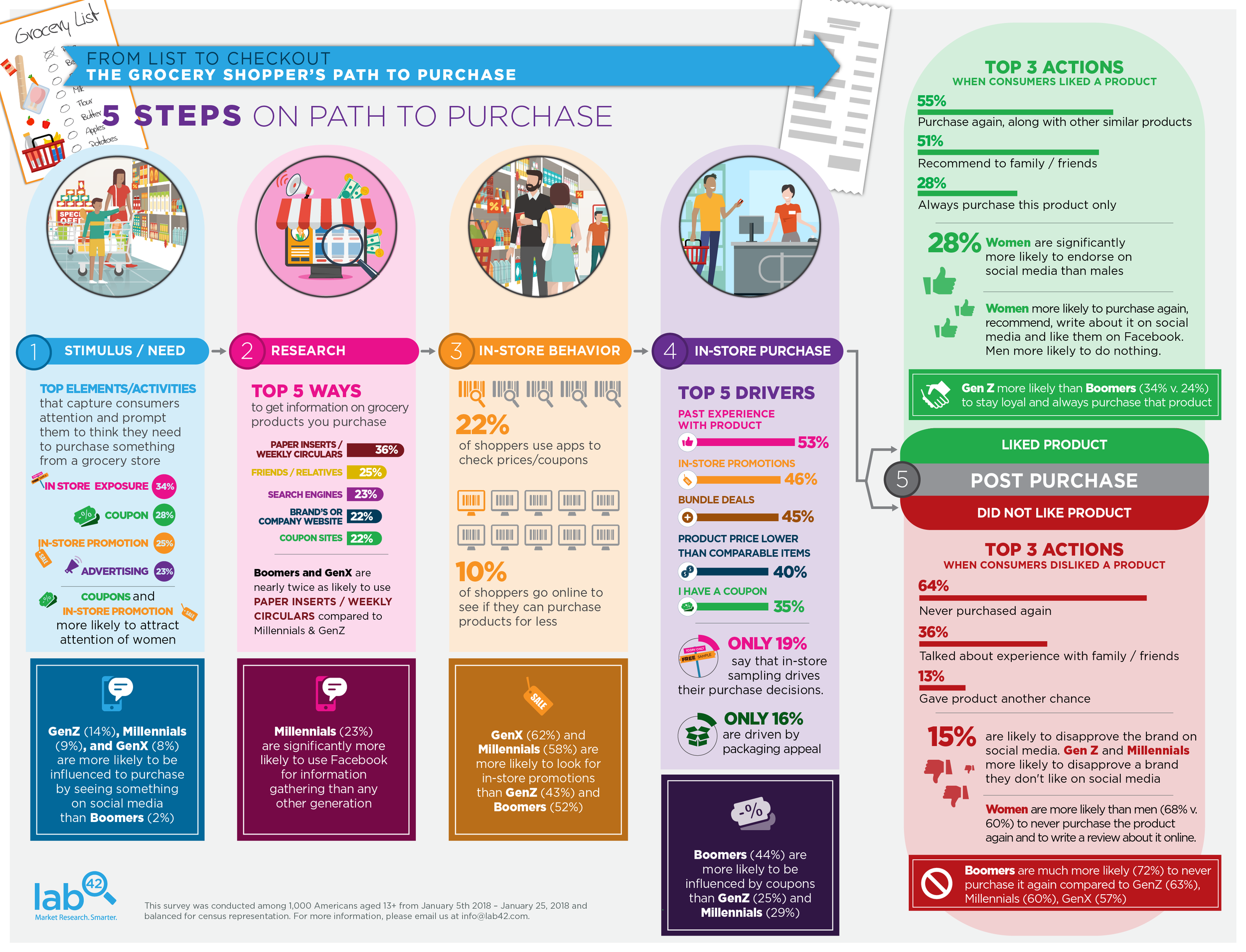GROCERY SHOPPER PATH TO PURCHASE
The consumer’s path to purchase – the steps that are taken both pre-purchase and post-purchase – has been studied profusely as it helps marketers understand the everchanging influences on shoppers.This topic interested us here at Lab42, and we conducted Path to Purchase studies across several industries - including grocery, retail and electronics. This first infographic highlights the purchase influences on grocery shoppers, as well as similarities and differences across generations.Stimulus
Top elements/activities that capture consumers attention and prompt them to think they need to purchase something from a grocery store:
In store exposure
Coupon
In store promotion
Advertising
Coupons and in-store promos more likely to attract attention of females, while for males ads or direct requests from family and members.
GenZ, Mill and Gen X are more likely to see something on social media or read reviews online
Research
Top 5 ways to get information on products you purchase
Paper inserts / weekly circulars (36%)
Friends / relatives (25%)
Search engines (23%)
Brand’s or company’s website (22%)
Coupon sites (22%)
Boomers and GenX are nearly twice as likely to use paper inserts / weekly circulars compared to Millennials & GenZ, but GenZ & Millennials are nearly twice as likely to use Search Engines than the older generations.
Millennials are significantly more likely to use Facebook for information gathering than any other generation.
In-Store Behavior
Top 3 in-store behaviors
Look for in-store promotions (54%)
Compare prices for several similar products (51%)
Only purchase items on shopping list (31%)
Women are much more likely to look for in-store promotions & use an app to check prices/coupons than men
Men are significantly more likely than women to only purchase items that are on the shopping list.
GenX & Millennials are more likely to be driven by in-store promotions than GenZ or Boomers.
Purchase– What actually impacts your decision on what products to buy?
Top 5 Drivers
Past experience with product (53%)
In-store promotions (46%)
Bundle deals (buy 1 get one free, etc) (45%)
Product priced lower than comparable items (40%)
I have a coupon (35%)
Only 19% of grocery shoppers say that in-store sampling drives their purchase decisions.
Only 16% of shoppers are driven by packaging appeal, with Boomers least likely to be influenced by packaging (6%)
Women are more likely than men to be driven by cheaper options; coupons; in-store promotions and instore sampling
Post purchase – liked product
Top 3 actions
Purchase again, along with other similar products (55%)
Recommend to family / friends (51%)
Always purchase this product only (28%
Women more likely to purchase again, recommend, write about it on social media and like them on FB. Men more likely to do nothing.
GenZ more likely than Boomers (34% v. 24%) to stay loyal and always purchase that product
Post purchase – did not like product
Top 3 actions
Never purchased again (64%)
Talked about experience with family / friends (36%)
Gave product another chance (13%)
Women are more likely than men (68% v. 60%) to never purchase the product again and to write a review about it online.
Boomers are much more likely (72%) to never purchase it again compared to GenZ (63%), Millennials (60%) and GenX (57%).
Only 6% of Boomers would give the product another chance
Please feel free to reach out if you would like the full report on the Grocery Shoppers' Path to Purchase.

